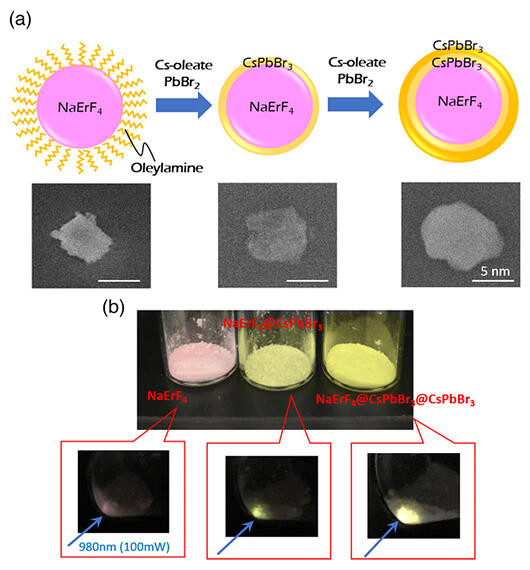Associate Professor Ayumi Ishii of the Faculty of Life and Environmental Sciences, Teikyo University of Science, Specially Appointed Professor Tsutomu Miyasaka of the Faculty of Biomedical Engineering, Toin University of Yokohama and their colleagues have developed a new near-infrared sensor using materials that convert weak near-infrared light to visible light. This was published in the online version of Advanced Photonics Research.

Near-infrared rays are used in various fields, but high-sensitivity detection of these rays is difficult. Compound semiconductors devices with an optimal absorption range of 900-1700 nanometers are materials used to detect light from the near-infrared region, but due to their complex manufacturing process, which uses rare metals, they are expensive, and have major limitations due to noise, so they are not as accurate for visible light detection compared to devices using silicon and similar materials.
The research group has developed high-density, high-luminance, rare earth upconversion nanoparticles to convert weak near-infrared light to visible light. Conventional upconversion nanoparticles, which include rare earth ions, have an extremely low light emission efficiency of less than 1%, and their absorption of near-infrared light is very weak, so strong laser irradiation is needed. This and other factors meant that researchers considered it difficult to efficiently convert weak near-infrared light to visible light.
By maximizing the concentration of the luminescent species within the particles (erbium), the group increased their near-infrared light absorption strength by a factor of 100. Moreover, to suppress energy deactivation (reduced vibrations) in the upconversion emission process, and to increase the typical nanoparticle dispersity, the chain-like organic molecules coating the surface were replaced with a low-vibration inorganic layer.
As a result, the group succeeded in increasing the upconversion emission efficiency of less than 0.01% to over 5%. The inorganic layer used as a shell is CsPbBr3, a perovskite material. Perovskite materials, which include heavy atoms, can suppress thermal vibrations that deactivate light emissions to the greatest extent possible, and so are able to significantly increase the brightness of the upconversion emissions.
Moreover, by coating the upconversion nanoparticle surface with a perovskite layer, it is easy to incorporate this into perovskite thin film (CsPbI3), which functions as a light-receptive layer for visible light, enabling the formation of a highly crystalline, uniform thin film. Normally, introducing nanoparticles and/or organic molecules to an inorganic semiconductor layer leads to the loss of the inorganic semiconductor's own characteristics, such as film properties or electric conductivity, due to the formation of an energy barrier, contact resistance and defect sites resulting from the differences between the organic and inorganic properties. In this case, the group succeeded in solving this problem by using the same kind of material (perovskite) for the nanoparticle surface and the light-receptive layer.
Moreover, using this thin film that incorporates the upconversion nanoparticles to create a photodetector meant that the group observed a current response to weak near-infrared light over 800 nanometers that could not be detected with perovskite alone. Only 0.5 volts are needed to run this photodetector. The external quantum efficiency (photoelectric conversion efficiency) reached 75%, and the group succeeded in the highly efficient conversion of weak near-infrared light (something that was considered difficult to detect with high sensitivity) to electrical signals via low voltage application.
Although there were issues with the response speed, the group has significantly improved the detection efficiency of weak near-infrared light through their new method of converting near-infrared light to visible light, which can be detected with high accuracy using existing technology and materials.
It is hoped that converting weak light in the near-infrared region, which is hard to detect in sunlight and to use as energy, to visible light and making use of this will lead to great improvements in the efficiency of the use of sunlight in artificial photosynthesis and in the optical sensitivity of light sensors to near-infrared light.
Journal Information
Publication: Advanced Photonics Research
Title: Upconverting Near-Infrared Light Detection in Lead Halide Perovskite with Core-Shell Lanthanide Nanoparticles
DOI: 10.1002/adpr.202200222
This article has been translated by JST with permission from The Science News Ltd. (https://sci-news.co.jp/). Unauthorized reproduction of the article and photographs is prohibited.




